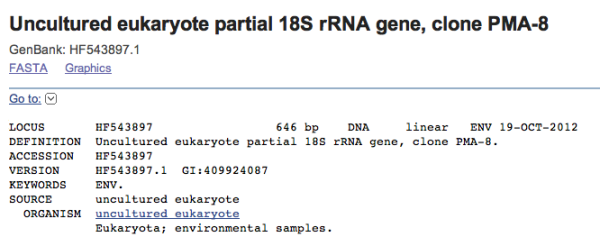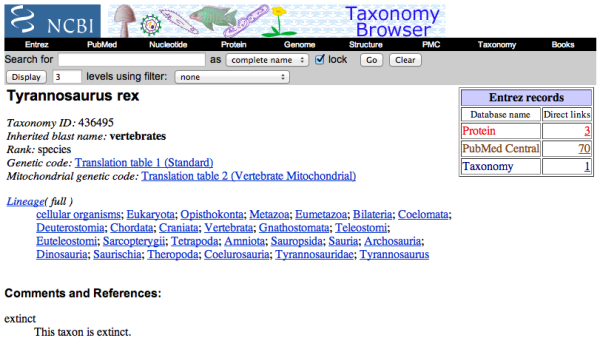My fellow Deeplings have been barraging the blog with “Best of” and “Top 10” lists in recent memory. Now its my turn to chime in.
Only…I don’t work with actual animals. I work with DNA sequences. I spent my PhD sitting under the microscope, where I vowed never again! Now I work with gigabyte-sized text files listing millions of gene sequences.
However! That will not stop be from pontificating on the Top 10 scariest species that I encounter in my daily life as a (computational) marine biologist. Be warned…you might not be able to sleep tonight.
5. “Environmental” species
Stop the presses. Big news. There are species. And they live in the environment. WHOA! This is news to me. I had no idea – someone needs to call the president! “Environmental species” are petrifying because you have no idea what they are. I mean I could have just sequenced Godzilla from my deep-sea mud (maybe I sampled next to his undersea lair?).
For anyone that works with DNA, it is common knowledge that database sequences are 100% trustworthy and researchers make every effort to put informative names on any data they submit. No scientist would be so cavalier as to dump thousands of unnamed sequences into GenBank. And GenBank certainly would never get clogged up with said type of sequences. So you see, I am still left scratching my head at my “environmental species” result.
4. “No Match” Species
These species have no good match to ANY DNA sequence listed in public databases. You should be terrified. What if we live in the Matrix, and DNA from these species has been conveniently erased from the reality construct? Or what if its Aliens?! The government might not want me to find a match for these bits of DNA.
You all know that we’ve done an amazing job counting and describing all the species that existed ever, so much so that scientists have now extensively characterized pretty much all the biodiversity on earth. The appearance of new species is practically unheard of. We’ve named all the worms and bacteria, and the thought of a new mammal species makes me roll over with laughter. Given our current state, I am left shaking in terror at my enigmatic “no match” DNA results.
3. Homo sapiens
Holy Crap, look at all that human DNA! There’s no ambiguity about what species I found, because this sequence has a 100% match to Homo sapiens. And it isn’t just one sequence. There are hundreds! This is frightening. What if my marine mud sample was collected on the EXACT SPOT where Jimmy Hoffa’s body is buried. All that human DNA I found could be evidence in a murder scene.
At least I can be sure that this is not routine contamination from the lab, because that never happens and all my data is 100% most certainly trustworthy. Should I call the police?
2. Command line error species
OMG I tried to process data and I discovered something I’ve NEVER SEEN BEFORE. And then I searched Google! The only person that has ever seen this before is Joe Programmer who asked about the SAME THING on a biology newsgroup back in 1996. But this thing I found is unknown in the scientific literature. Its like I stumbled upon a mythical creature that had been lurking amongst us all along. Soon the world will build statues!
I pressed a button and did everything the software tutorial said, so these results must be right. I’m the best computer user in the world! More so, all computer programs automatically know how to process our DNA data – because the biology is so simple!
My new species is scary because I don’t know if people will understand. What if they react badly to the news that I’ve just described use of uninitialized value $ncbi_name in concatenation (.) or string from the deep sea?
1. Tyrannosaurus rex
You heard me. Dinosaurs lurk amongst us. How do I know? Because the DNA TOLD ME SO. When processing my deep sea data, I found a sequence whose best match was to the T. rex sequence listed in GenBank. Either there are dinosaurs walking the earth (whereby I collected my sample in a fresh T. rex footprint), or T. rex DNA is so indestructible that it survived floating around in the dirt for millions of years. Either way I’m shaking in my boots.
There’s no way that that the information I got from GenBank is wrong. Because who would ever confuse DNA from common soil bacteria with DNA from a T-Rex fossil?! And there are three T. Rex protein sequences in the database. No one would mess that up multiple times. Which means I have to go find an underground bunker, because I have a sinking feeling that Jurassic Park was actually a documentary…








Ah, lab frustration…
I hear ya, sister! :)
So next time I am sheltering in a primitive tent high in the rain forest how am I supposed to sleep ?
First,I am curious how you would proceed to determine a sequence is truly alien–not from planet earth. How would that differ from a previous unknown species or a completely new species? Second if it is alien, could you determine its age in the sense that it was just recently placed here or if it was deposited here thousands or millions of years ago? Third, exactly how is the DNA sequence different?
First I laughed out loudly but then I was petrified. I actually encountered four of those myself (not the T. rex though). Does that mean they are really out there? Do we have to reconsider everything we thought we know about biodiversity?
I am not gonna sleep well coming night.
Binary species are scary [Y/N]?
@ lee:
While we wait for the factual biologists to respond, my astrobiology interest compels me:
All life is related by trees, and the Precambrian rabbit or today’s alien would stick out. Say, not using a related genetic machinery in the latter case, the machinery and its relatedness which (together with modern math) was what let Theobald test the universal common ancestry of all life. I.e. the trees make one tree.
And at ~ 10^-2000 likelihood for random observation due to the combinatorics of tree topologies, it is the best observation of all of science and the best there will likely ever be.
Of course the resolution of excluding aliens vs trees may not be all that good in practice. Back to the genome experts…